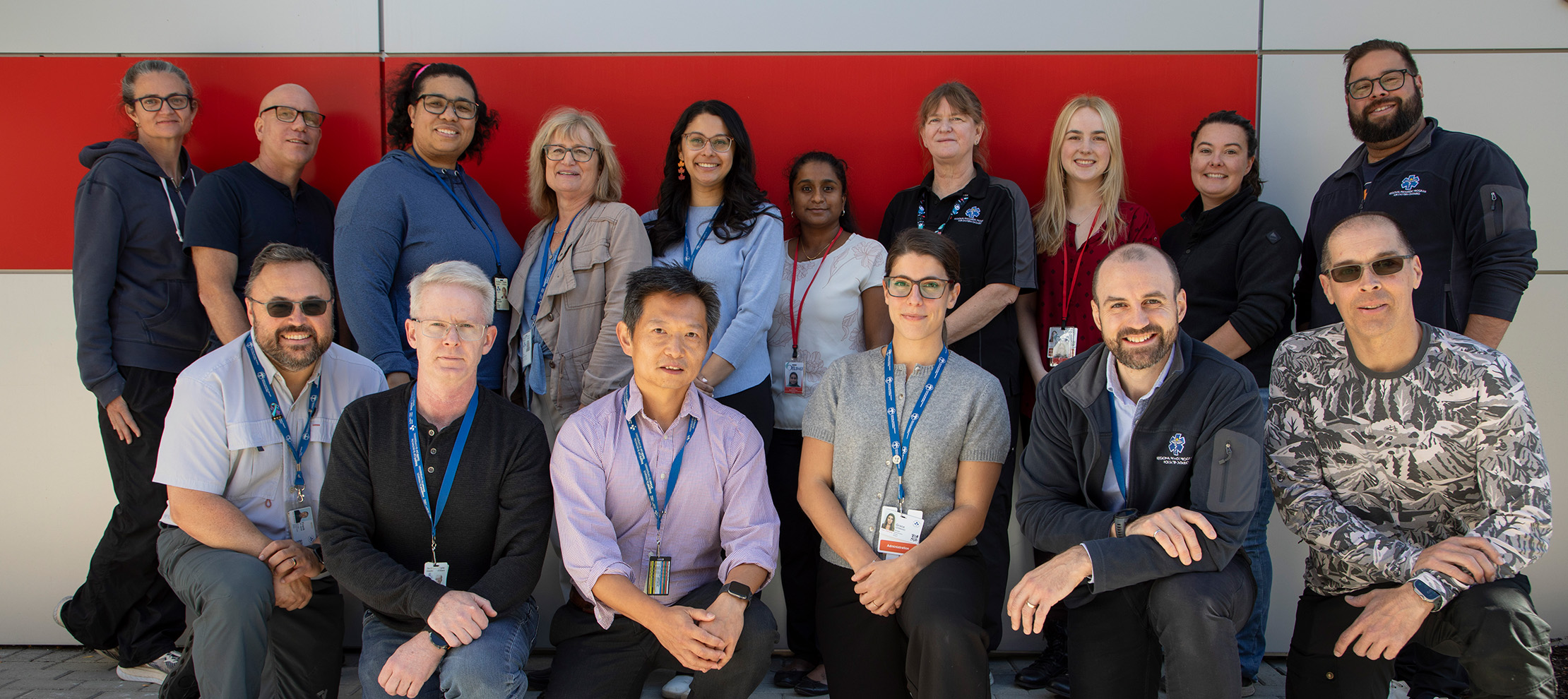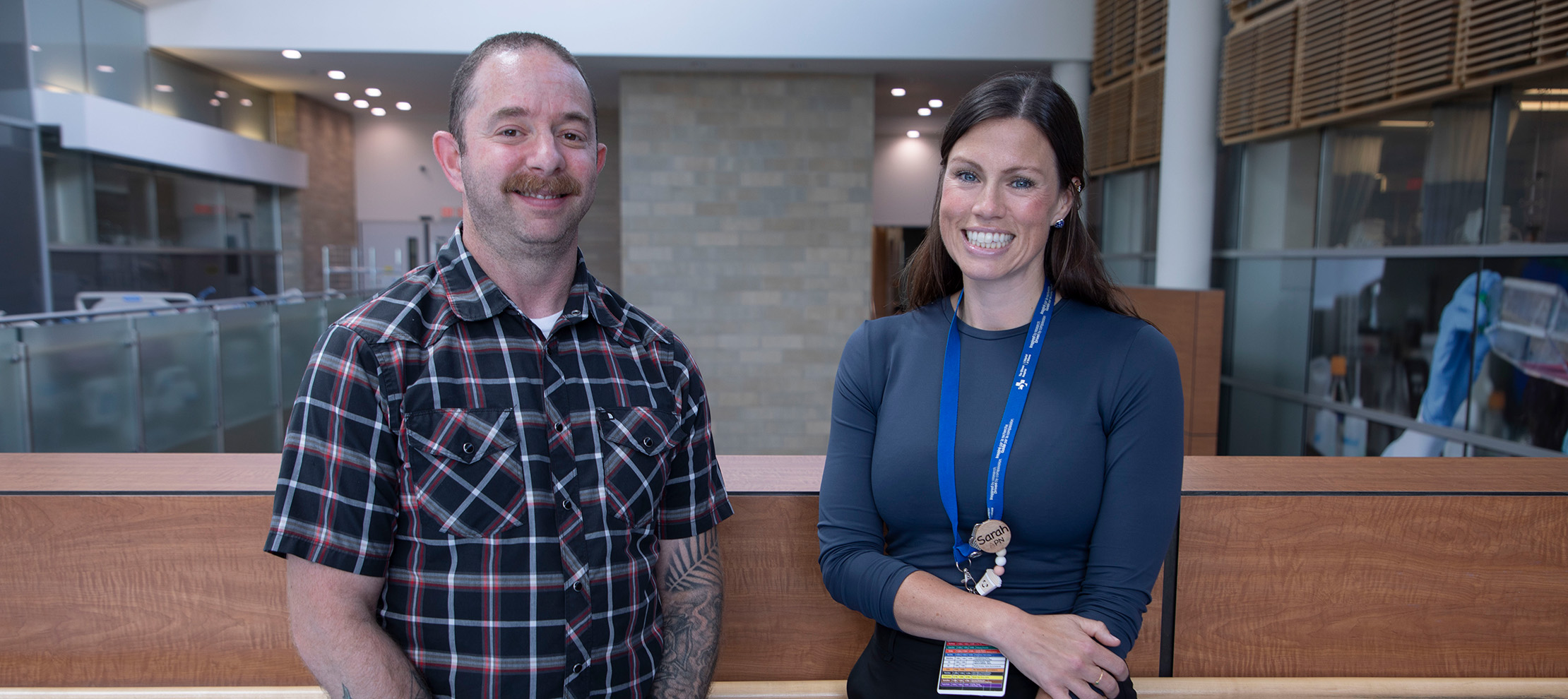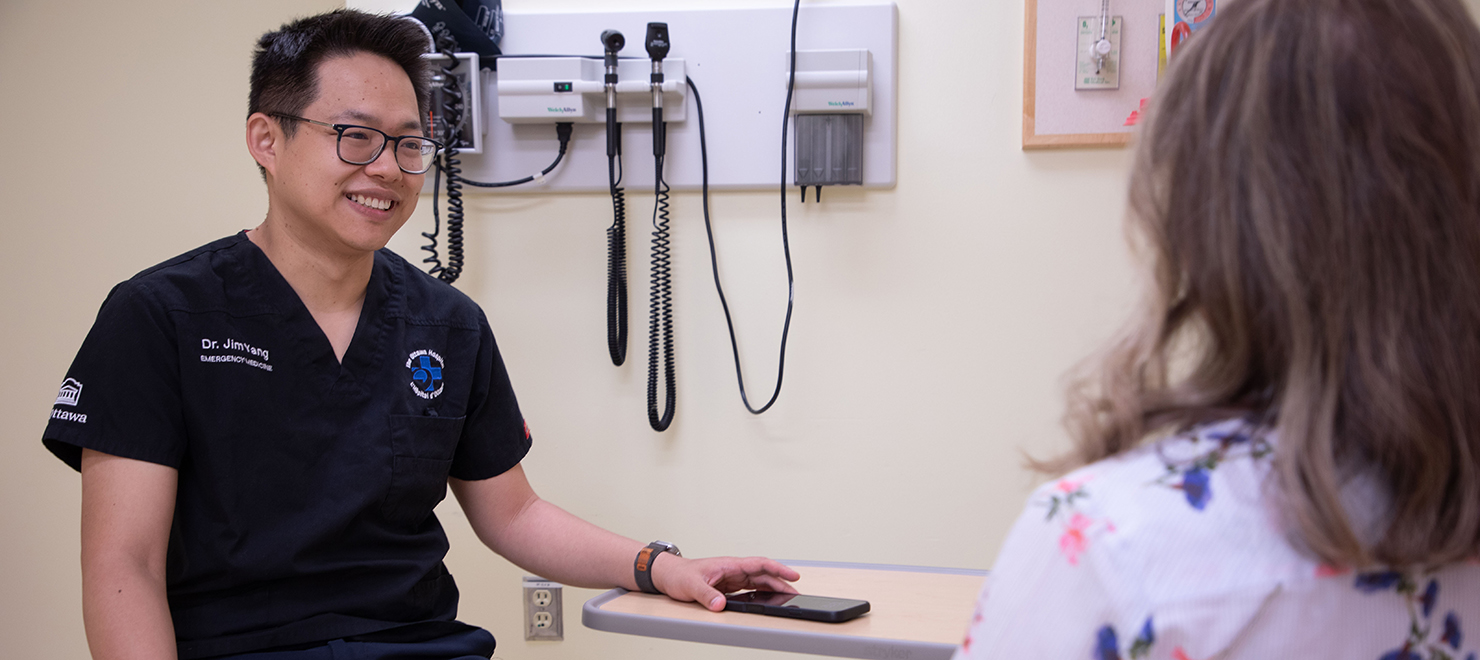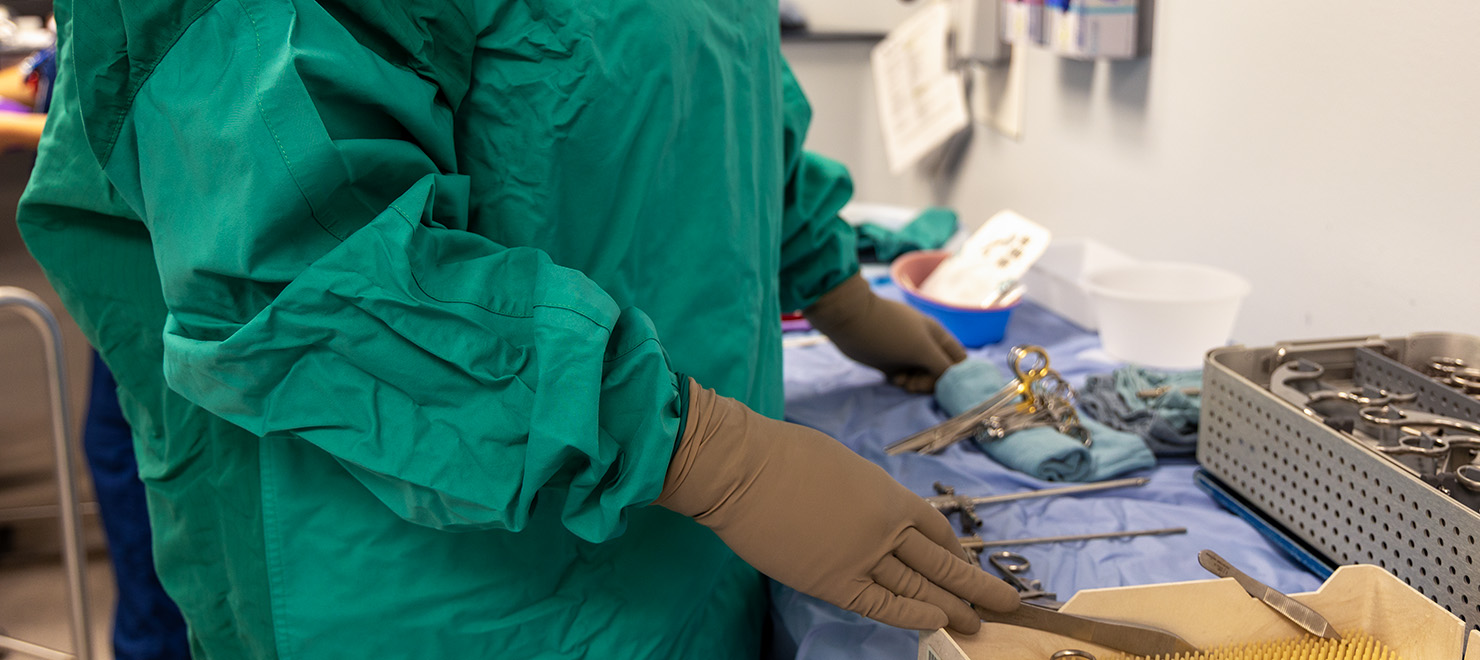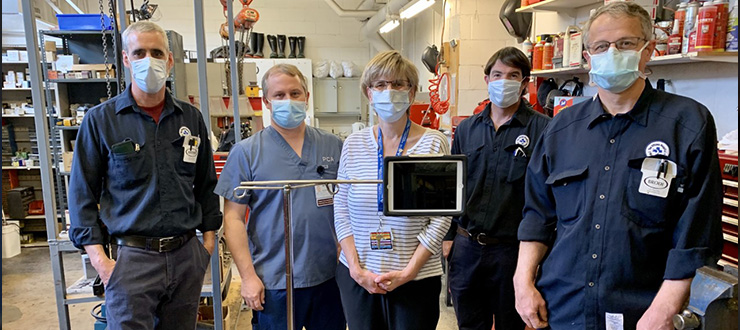
[Left to right: Patrick Shea, Darren Theoret, Jane Mahoney, Harold Ready, Milan Karajovic] They and others all played a part in creating the tablet holder so that patients could connect with their families virtually and comfortably.
Technologies like tablets have helped many of us connect with loved ones in the era of physical distancing. But for some patients in the hospital, including those in COVID-19 units, holding a device for a video chat just isn’t possible.
Thanks to some ingenuity, teamwork and an old IV stand, some patients can now have hands-free video chats with their families.
The idea came about when Darren Theoret, an orderly on a COVID-19 unit at The Ottawa Hospital watched as social worker Jane Mahoney held a tablet for a patient so that he could have a video chat with his family while lying down in his hospital bed.
“You are just connecting on a whole other, more meaningful level.”
Darren noted that having a staff member hold the tablet at the patient’s bedside gave the patients less privacy and meant that the staff member could not perform their other duties for the duration of the chat.
“I thought, ‘there’s got to be a better way to do it,’” he said “so I went down to the guys in the welding shop and they were all for it. They built this little contraption to hold the tablet and mounted it to an IV pole.”
Milan Karajovic, Harold Ready, and Patrick Shea, millwrights at The Ottawa Hospital put it together. Their supervisor, Don Taggart, found the IV pole.
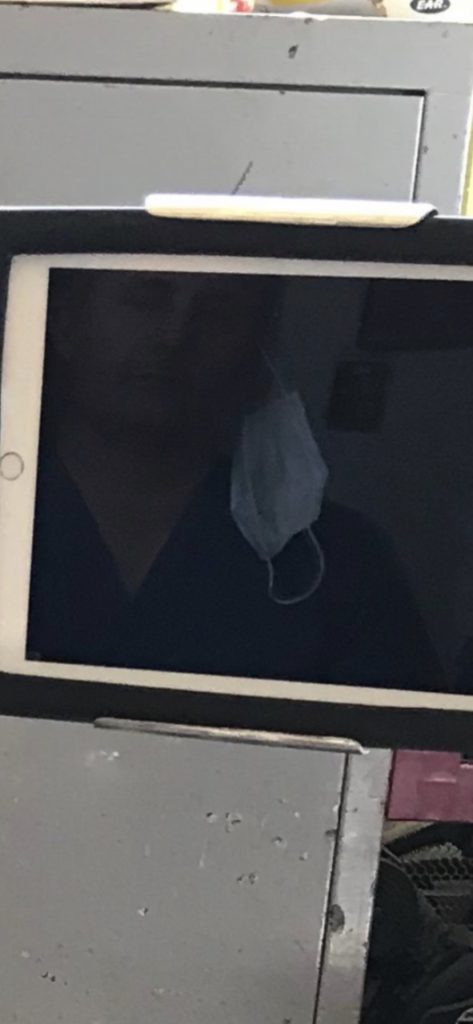
Its simple design is easy to set up, easy to adjust, easy to clean, and easy to move around the unit as needed. It was a big improvement from the makeshift solution of propping the tablet up using tissue boxes and flashlights on a patient’s bedside table. Plus it meant that patients who needed to stay lying down completely could have the tablet held safely in front of their face.
The unit clerks in the ICU help set up the tablets and keep them charged and ready for patients to use. Because it’s so portable and easy to use, anyone on the unit – nurses, respiratory therapists, orderlies and others – can easily set it up.
Although there are still many phone calls between patients, families and care providers, there is something special about being able to see each other on screen.
“It gives everyone the ability to connect on a visual level, which is important because so much communication is non-verbal,” said Jane. “I think it’s also important for families to see the faces of the people who are caring for their loved one here. You are just connecting on a whole other, more meaningful level.”
Jane has also used the video chat feature on the tablet herself to connect with families during particularly difficult conversations, including end-of life care.
“Sometimes I step out of the patient’s room into the hallway and take my mask off to say ‘this is me. This is who I am,’” she said. “It helps us connect in a way that’s not as easy over the phone.”
“They took the idea and ran with it.”
Virtual visits are becoming more common in COVID-19 units and elsewhere in the hospital. Nurses in particular are incorporating this technology into how they care for patients and communicate with families during the pandemic.
Patients and their families are overwhelmingly appreciative for the chance to connect with each other this way.
“I think I’ve heard more gratitude from patients in the past little while than I’ve ever heard in my 22 years here,” said Jane.
So far, one specialized stand has been created, but the welding shop is ready to make more if the demand grows.
“The guys in the welding shop are the ones who deserve all the credit,” said Darren. “They took the idea and ran with it, and had it ready for us in less than two hours. They are always willing to help out. They’re a really important part of the hospital team.”

Support patient care and research at
The Ottawa Hospital
You might also like…
How we’re helping over 1,400 paramedics enhance patient care and safety
The Regional Paramedic Program for Eastern Ontario (RPPEO) is on a mission to enhance what happens after you dial 911. Here are three new ways this team is helping paramedics deliver better, safer care to their patients.
New program fills gap in care for teens and young adults with cancer
For young people, a cancer diagnosis can disrupt their education, careers, relationships and family-building goals. Our Adolescent and Young Adult (AYA) Cancer Program supports AYAs on their cancer journey, complementing the care provided by their care team.
Less time charting means more time with patients: How The Ottawa Hospital is using AI to support patient care
“I’m seeing and treating more patients.” Find out how DAX Copilot, a powerful AI assistant, is helping our physicians cut down on paperwork, improve their own well-being and spend more time with patients.
New reusable surgical gowns a step towards greener operating rooms
The Ottawa Hospital is finding safe, innovative ways to reduce medical waste in its operating rooms by using more environmentally sustainable products.
“Crash testers”: Preparing our health-care teams for real-life emergencies
Swapping patients for manikins, our Simulation Patient Safety Program recreates medical emergencies right in our hospital, allowing our care teams to “crash test” their responses to cardiac arrests, respiratory failures, mass casualty events and more. Dive into this Q&A for a closer look at how this training program enhances patient safety and quality of care.
The place to be: The Ottawa Hospital recognized as one of Canada’s most admired corporate cultures
The Ottawa Hospital (TOH) has been named one of Canada’s most admired corporate cultures. Guided by compassion and commitment to patient care, TOH has developed a workplace culture that inspires confidence and trust in our employees, patients and family members.


 To reset, hold the Ctrl key, then press 0.
To reset, hold the Ctrl key, then press 0.
